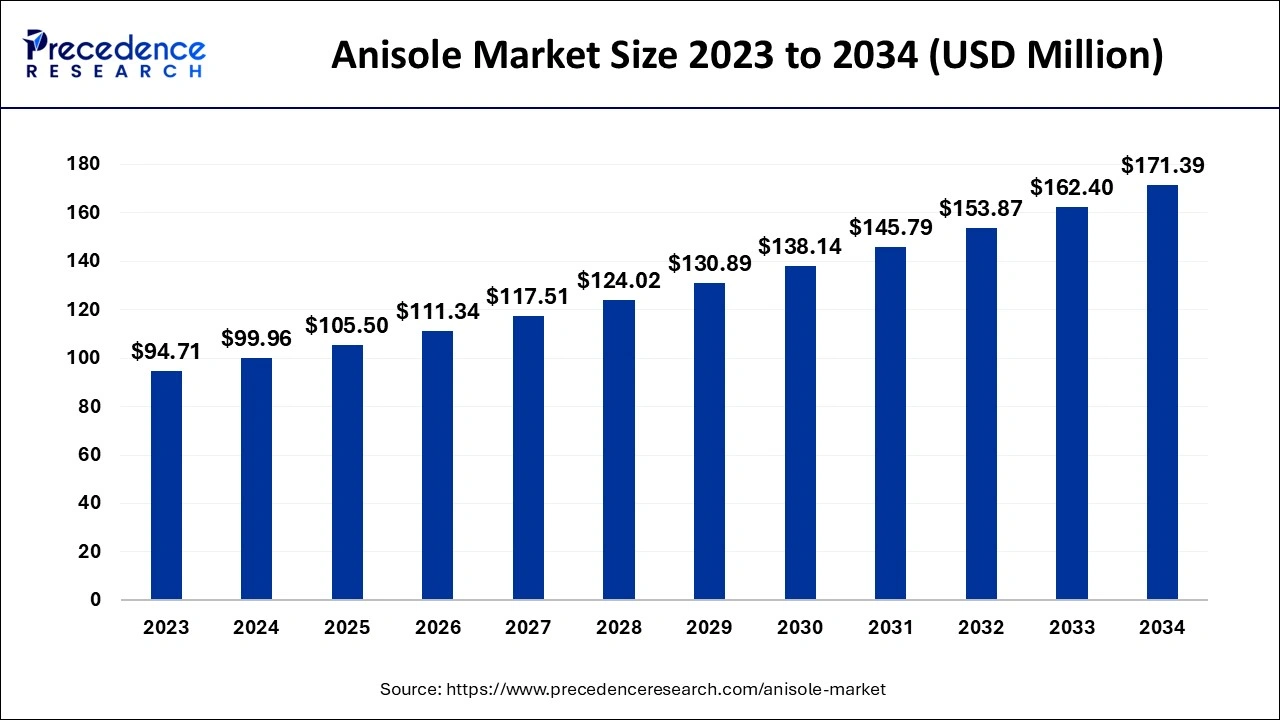 Anisole Market Key Takeaways
Anisole Market Key Takeaways- North America dominated the global market with the largest market share of 30% in 2023.
- Asia Pacific is anticipated to grow at the fastest CAGR during the forecast period.
- By grade, the up to 99.5% segment contributed the highest market share of 65% in 2023.
- By grade, the above 99.5% segment is expected to grow at the fastest CAGR of 6.14% during the forecast period.
- By application, the perfumes segment captured the biggest market share of 53% in 2023.
- By application, the pharmaceuticals segment is anticipated to grow with the highest CAGR of 5.43% during the studied years.
Market Overview
The anisole market is an integral part of the global specialty chemicals industry, catering to a broad array of applications in pharmaceuticals, perfumes, and agrochemicals. The rising preference for aromatic compounds in everyday consumer products is a major force behind the anisole market’s growing prominence.
Anisole is utilized extensively as a starting material in the synthesis of numerous compounds due to its chemical reactivity and solubility. With a strong foundation in both research and industrial usage, the anisole market is entering a phase of consistent development across major regions and sectors.
Drivers
Growth in the anisole market is largely driven by increasing demand for flavoring agents and aromatic compounds in personal care and food industries. Additionally, its wide application in the formulation of pesticides and herbicides underpins its relevance in the agrochemical segment.
Rapid industrialization and the diversification of downstream applications such as colorants and resins also contribute to expanding the anisole market. Furthermore, rising awareness regarding the use of high-purity chemicals in the pharmaceutical industry supports the continuous demand for anisole as a reliable intermediate.
Opportunities
The anisole market offers significant opportunities for companies focused on sustainability and green chemistry. There is a rising trend of substituting synthetic intermediates with environmentally benign chemicals, which favors anisole due to its biodegradable properties. Expanding into developing regions where the cosmetics and pharmaceuticals industries are flourishing provides a strategic opportunity for market penetration.
Moreover, innovation in bio-based extraction methods and catalytic processes can give manufacturers a competitive edge in the anisole market, particularly among eco-conscious consumers and regulators.
Challenges
Despite its advantages, the anisole market contends with challenges such as raw material price volatility, which can affect production costs. Another barrier includes environmental and regulatory compliance, especially in countries with stringent chemical usage laws. The anisole market must also overcome supply chain disruptions and operational inefficiencies that affect timely delivery and quality control.
In addition, competition from low-cost synthetic alternatives could impact margins and market share. These factors demand strategic planning and operational agility to maintain competitiveness in the anisole market.
Regional Insights
Asia-Pacific dominates the anisole market owing to strong manufacturing capabilities and high consumption in end-use industries. In particular, China and India serve as major contributors to both domestic use and export. North America holds a stable position, supported by technological innovation and demand from fragrance and pharmaceutical companies.
Europe, with its emphasis on environmental regulations and quality control, remains a sophisticated market with high-value applications. Other regions, such as South America and Africa, are emerging in the anisole market landscape as local industries seek to incorporate advanced chemical intermediates.
Recent Developments
Recent shifts in the anisole market include the adoption of cleaner production technologies and an emphasis on waste reduction during synthesis. Mergers and strategic alliances are helping companies scale operations and access broader distribution networks. Investment in capacity expansion and R&D, particularly in Asia, reflects growing confidence in the anisole market’s future.
Patent activity surrounding new derivatives of anisole also suggests heightened innovation. These trends indicate a proactive effort by industry players to strengthen their market position and meet evolving consumer and regulatory expectations in the anisole market.
Anisole Market Companies
- Atul Ltd
- Benzo Chem Industries Pvt. Ltd.
- Camlin Fine Sciences Ltd.
- Emmennar Pharma Pvt. Ltd.
- Evonik Industries AG
- Merck KGaA
- Solvay
- SURYA LIFE SCIENCES LTD.
- Thermo Fisher Scientific
- Tokyo Chemical Industry Co., Ltd.
- Westman Chemicals Pvt. Ltd.
Segments Covered in the Report
By Grade
- Above 99.5%
- Up To 99.5%
By Application
- Perfumes
- Insect Pheromones
- Pharmaceuticals
- Others
By Geography
- North America
- Asia Pacific
- Europe
- Latin America
- Middle East and Africa
Ready for more? Dive into the full experience on our website!